Helping to bring closure
Search Dog Network assisted the Wortham, Texas Police Department in August. Canine Remi located the remains of the man, who had been missing for nearly a month. Here is a link to an article about the search.
Search Dog Network assisted the Wortham, Texas Police Department in August. Canine Remi located the remains of the man, who had been missing for nearly a month. Here is a link to an article about the search.
Friends of Search Dog Network, we have chosen to participate in Brazos Valley Giving Day, an 18-hour event to be held on October 22, 2019. We humbly ask that you consider supporting us with a donation on that day, or beginning October 8th for pre-scheduled donations.
We are a 501(c)(3) organization that provides search services at no cost to the requesting agency. Search Dog Network is a 100% volunteer team of unpaid professionals. We receive funds from our members, grants, and donations. Any funds donated will be used to purchase equipment to help us search more safely or effectively.
While our primary search area is the Brazos Valley (Brazos, Burleson, Grimes, Leon, Madison, Milam, Robertson and Washington Counties in Texas), we respond outside of this area when contacted by Law Enforcement or when requested as mutual aid by another Search & Rescue resource.
Donations on the Brazos Valley Giving Day web page may start at $10, with no maximum limit, and are open to anyone inside or beyond the Brazos Valley. Receipts for tax purposes will be provided within an hour of donation.
Thank you for your support!
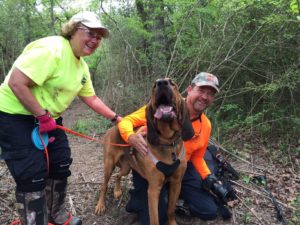
SDN team member Mark, serving as a mock victim for a trailing test, just after he was located by canine Woodrow and handler Karen from Alamo Area Search & Rescue.
Search Dog Network’s mission is to train, certify, and deploy professional canine search teams to locate missing persons. In keeping with our mission, our canines participate in a national certification test every two years through the International Police Work Dog Association (IPWDA). In collaboration with our response partners, SDN hosted this year’s test the first weekend of April. Throughout the weekend, 27 canine and handler teams from 7 canine search and rescue teams challenged the IPWDA certification standards for air scent, trailing, and human remains detection on land, shoreline, and water.
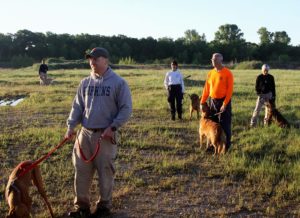
Canine and handler teams perform the obedience portion of the test. Canines Sophie, Sonic, Taser, and Kaja Joe demonstrate on-lead behavior.
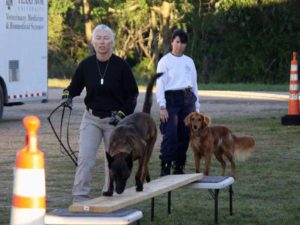
Canine Kaja Joe is guided across a plank by handler Tami from Travis County Search & Rescue while canine Taser looks on with handler Denise from Cy-Fair Fire Department.
IPWDA testing for canine wilderness search involves an obedience and agility component. For the past couple of months, our canine teams have been practicing a group “down-stay,” walking at a heel, coming on command, walking across a plank, and allowing new people to load the dog into their car. Canine obedience both individually and in a group is crucial for the safety of dogs—especially in some of the terrain and weather conditions we face in this part of Texas.
The search portion of the test varies for each type of dog. Wilderness air scent dogs searched a 40 acre search segment, whereas human remains detection dogs searched a 2 acre segment (per IPWDA standards). Both testing scenarios have a time limit and could include up to two mock victims. Testing trailing dogs required more careful planning, because the mock victim had to lay a trail several hours in advance and remain in place until the search test was complete. These dogs used a scent object from the mock victim to help locate the trail.
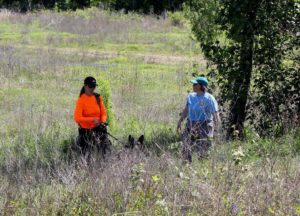
Human remains detection canine Remi and handler LaNell return from the field after their test.
Water test scenarios for human remains detection dogs included a shoreline test with the source a few feet underwater near a shoreline or involved the canine perching on the bow of a boat sniffing for source fully-submerged in a larger body of water. Water testing for canines is a more advanced skill that takes lots of practice. Search Dog Network is often called to help with water searches, so we practice water searching as frequently as we can.
Setting up testing was an intense team effort and required careful coordination of resources. SDN found a suitable testing location, mapped out search segments for each type of test, planned and coordinated the testing schedule with all the testing teams, recruited mock victims for the air scent tests, and managed the logistics of test days with resource tracking from the SDN trailer, on-site veterinary care, transportation, and refreshments for all those testing. While weather conditions were near-perfect during the first two testing days, intense storm forecasts for the third required on-the-fly adjustments to condense three days of testing into two so that all canine teams could safely test before the bad weather arrived. Our SDN testing coordinators, Matt Young and Teresa Medearis did an amazing job with these schedule changes and all testing teams were fairly accommodated.
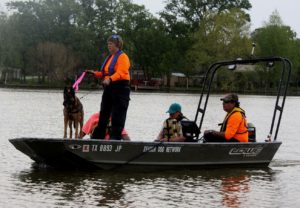
Human remains detection canine Noggin and handler Teresa during their water test. SDN member Chris serves as boat operator.
In all, SDN certified 4 new canine handler teams and recertified 5 veteran canine handler teams, doubling our canine resources. Congratulations to all who challenged and passed the test!
Recertified Handlers:
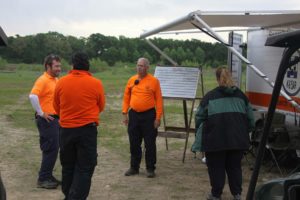
Jim, Matt, and Chris confer at the SDN trailer, which served as the operations base for resource tracking and communications.
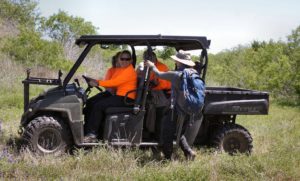
SDN team members shared logistics duties during the testing. Leiha drives the gator to transport testers to and from their testing locations
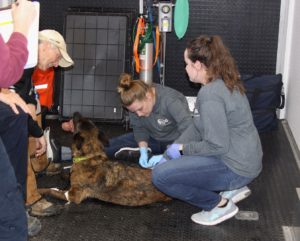
Vet student volunteers from the Texas A&M Veterinary Emergency Team provided on-site care for canine Kaja Joe of Travis County Search & Rescue.
Photos are courtesy of Mark Garton.
Every year, Brazos Valley Search & Rescue (BVSAR) hosts an annual mock deployment exercise. BVSAR is a consortium of emergency response teams in the Brazos Valley who unite in response to missing and lost persons incidents. On Saturday, January 28th, Search Dog Network joined members of BVSAR in the annual exercise at Grimes County at Gibbons Creek Reservoir. The mock search scenario was a response to a boating accident resulting in three missing people. Response partners for the exercise included Grimes County Fire Department, Bryan Fire Department, Washington County Fire Department, Rocky Creek Volunteer Fire Department, Shiro Volunteer Fire Department, Amateur Radio Emergency Service (ARES), Citizens Air Patrol, the Center for Robot-Assisted Search & Rescue (CRASAR) from Texas A&M University, and the Grimes County Citizens Emergency Response Team (CERT).
Water rescue teams from Bryan FD and Washington County FD deployed into the reservoir searching for the victims using assistance from both unmanned water and aerial vehicles. Ground searchers and a canine team deployed on land to search the thickly wooded land surrounding the reservoir. By the end of the day, all three victims (a live volunteer and two floating rescue dummies) were located. Practicing working together in a large scale exercise is vital for all the responding teams.
A water search scenario for the exercise was useful training for the responding teams because many real-life missions in recent years have been water-related. For Search Dog Network, two ground search teams deployed to search segments near the shoreline. SDN searchers wore the self-inflating personal flotation devices from our Water Rescue pack as a safety precaution because they were near the water. The Water Rescue pack is a recent addition to Search Dog Network resources and was funded through a donation to Search Dog Network from D. Grimm Inc.
Your dog’s eye is watering, sinks in and is reddened at times. Did he run into a mesquite shrub, get stung? Normal questions for SAR handlers and their trouble prone dogs! However, when the eye is involved, I recommend getting vet advice as soon as possible.

Brennan’s left eye was watering and sometimes reddened
Brennan experienced these symptoms and despite multiple vet visits, he lost vision in the left eye and eventually had to have it removed. We had participated in the free eye exam for service dogs several times at Gulf Coast Eye Clinic in Houston with some minor problems noted in his eye lids and a comment about the angles of his eye. Our last visit was in 2011. I should definitely have paid more attention to understanding the impact of bad angles. (By the way, this is an awesome opportunity for SAR handlers and their partners and I highly recommend you take advantage of it if you are eligible!! See ACVO/Merial Service dog eye exams, usually offered in the spring.)
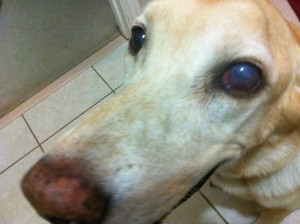
Brennan’s left eye, reddened
When the symptoms started, we treated him for an eye infection and he had a small mass on his shoulder that was a mast cell tumor. He was noted to be anemic during his pre op blood work, so we delayed the surgery. By the time we got his blood work more normal, the mass had disappeared. The eye had a small corneal ulcer that we also treated.
We were referred back to the Houston eye clinic and they got us in quickly, just to confirm that he was blind in the left eye and given the diagnosis of glaucoma. Treatment began – there were 3 sets of drops for the involved eye (2- 3 x day) and 1 set of drops for the other eye (2 x day).
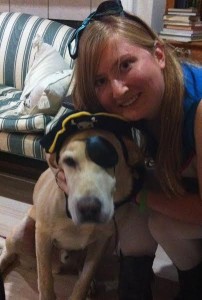
Brennan and Elyssa
By late September, we were losing the battle. The ulcer was progressing despite being trimmed and treated with antibiotics. He had been blind in the eye for some time with some compensation starting to evolve. The pressure in the eye was in the low 30s. Normal for a dog is 8 – 18. People report a great deal of pain and headache with elevated pressures and the vets believe he was also very uncomfortable.
The eye was removed in early October 2013, just after I had minor surgery as well. So we spent a few very quiet days and then began the journey back to work. To complicate matters, the mast cell tumor reappeared at his post op check for the eye. We waited a bit to allow recovery from the first surgery, then had the tumor and another small growth removed. After about 6 months, he had adjusted enough to catch a ball in the air, jump into the truck with only a minor delay, and return to full search training and his pet therapy visits.
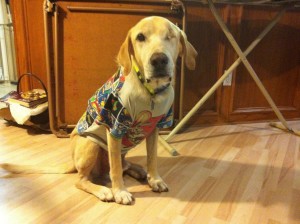
Brennan’s left eye was removed in October, 2013
Due to the abnormal structure of his eye, we treat the right eye with drops to control the pressure 2 x day. He is being monitored by Gulf Coast eye clinic veterinarians, who come to TAMU 2 x month, every 3 to 6 months. The pressure in his right eye is staying in the low range of normal with the medication.
The good news is that SAR dogs need their noses more than both eyes.
He assisted with a recovery for the team on a search in June 2014 and it was truly a celebration of healing and teamwork for our SDN family!

We still like to play
Brennan came from the San Marcos Animal Shelter in 2009, heartworm positive and underweight, but one happy dog loving to chase a ball and tug. I am privileged to share his journey and hope his story will help someone else catch this disease in their canine partner.
In May, Search Dog Network helped respond to the floods in Hays County. We responded with two human remains detection canine teams and several ground team members. There were numerous new lessons learned among all responders during this search, but two stand out that will improve how our team approaches working large scale floods.
The first was that a shoreline search can cover an enormous area of land because the waters continued to recede for weeks after such large scale flooding. What is shoreline today will not be part of the shoreline tomorrow, so an area may need to be continually re-searched at the waterline until the water fully recedes back to normal levels.
The second was that heavy equipment was used to efficiently shift large amounts of flood debris. Working safely around this equipment was an important part of the search. The use of spotters, proper procedures, and personal protective equipment was critical to a safe and effective operation.
In such a large search response, it was highly valuable to have an emergency veterinary team available to take care of the canines. During a natural disaster search like this, canines often returned from the field with minor scrapes from the difficult terrain and the need to be decontaminated with the emergency dog wash. It was also very important to pay attention to the dog’s heat tolerance, since not only can heat impact their ability to scent effectively, heat exhaustion is always a danger when working in Texas during this time of the year. To help offset risk, canine teams took breaks frequently and often worked smaller search segments.
Search Dog Network played a very small part in what was a tremendous effort in response to the Hays County flooding and we are grateful for all the logistics support provided to help our canine teams work with maximum effectiveness.
Our IPWDA evaluators were Dianne Bettis, Master Trainer and Evaluator from North Carolina and Mary Lehman, Evaluator from Texas. We invited our Response Partners to participate and wish to sincerely congratulate all Search Teams that passed:
Human Remains Search – Land
1. Katie Breland and Aziva from Search Dog Network
2. Matt Young and Zapp from Search Dog Network
3. Cindy Grant and Brennan from Search Dog Network
4. Christy Borman and Callie from Alamo Area Search & Rescue
5. Brian Deschenes and Rory from Alamo Area Search & Rescue
6. Rhywnn Gaffney and Luna from Travis County Search & Rescue
7. Sean Glynn and Max, Independent Handler
Live Find Wilderness Search – 40 Acres
8. Katie Breland and Aziva from Search Dog Network
9. Jim Yeager and Sonic from Search Dog Network
10. Christy Bormann and Cody from Alamo Area Search & Rescue
11. Joe Palfini and Sophie from Alamo Area Search & Rescue
12. Rhywnn Gaffney and Kenya from Travis County Search & Rescue
SAR Trailing
13. Amanda Ott and Izzy from Travis County Search & Rescue
Human Remains Search Water14. Mary Haislet and Noggin from Search Dog Network
15. Cindy Grant and Brennan from Search Dog Network
16. Teresa Medearis and Noggin from Search Dog Network
17. Katie Breland and Aziva from Search Dog Network
18. Debbie Parashak and Rory from Alamo Area Search & Rescue
After many months of hard work, SDN recently finished Phase I of our Operations Trailer project. The addition of the trailer allows us to access the computer and information systems required to manage a complex search operation within a secure and weather resistant environment. The trailer started life with Search Once Rescue Team of Lewisville, TX where it served as their operations center for 14 productive years. SDN acquired the trailer in June of 2012 and pressed it into service at a search in Milam County. We then began a long refit process building on the work of Search One.
Members spent many hours scraping, sanding, hammering, and rebuilding where necessary.
We were able to complete the work in stages, and continue to train with and deploy the trailer as required.
After many long days and late nights, Phase I is complete. Phase II will include improvements to the battery system, computer displays, and an expanded storage area. As anyone with an RV or boat will testify, there is always more work to do!
We could not have done it without the steadfast support of the following:
Search Dog Network would like to thank the Bryan-College Station Eagle for Wednesday’s wonderful article. We appreciate the opportunity to share the hard work of our two legged and four legged team members with the community!
Stuart Villanueva/ The Eagle
K-9 handler Mary Haislet of the Search Dog Network and her dog, Noggin, trek through the woods while training at Lake Bryan on Tuesday.
Follow the link for the full article: Training Pays Off for Bryan’s Search Dog Network
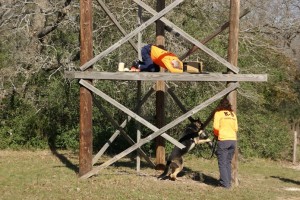
Kiba following trail to tower – Kocher seminar
In March 2013 SDN assisted TC Crippen, Seeker Dogs, Inc In hosting a trailing seminar with instructor Kevin Kocher. Attendees came from College Station, Bryan, Dallas, Fort Worth, Texarkana, Kansas, and other surrounding areas. Kevin’s health is deteriorating so for many of us, this was a once in a lifetime opportunity. Kevin has written a book called “The Kocher Method” describing his successful training methods. These methods have been adopted both nationally and internationally in places such as Germany, Ukraine, Netherlands, France, Italy, and elsewhere. Several members of SDN volunteered to be “rabbits” (trail layers) and learn more about this training style. Others assisted with food preparation to help attendees and instructors stay focused on the training (and maybe the desserts!)
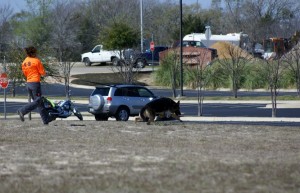
Kiba and Jeannette in training
Kevin’s method is extremely motivational, teaching the dog to follow scent rather than search for it. One dog, Kiba, from SDN participated in the seminar and has improved leaps and bounds in the past few months using the Kocher method. Several topics that were covered in the seminar include high finds, car pickups, drownings, crime scenarios, starting a new puppy, and plenty of urban search scenarios with cement as the trailing medium. Kevin helped everyone think critically and creatively about situations that they may encounter in a call out and taught them to expose their dogs to as many things as possible.
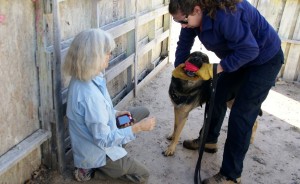
Rewarding Kiba for finding Cindy
SDN is extremely grateful for the experience Kevin and his instructors provided us with. We hope to bring along many more dogs with the help of his method and expertise. If you are interested in his method please visit http://www.bloodhoundtraining.com/for more information and feel free to come to a training to watch our dogs work! Or learn to be a rabbit!
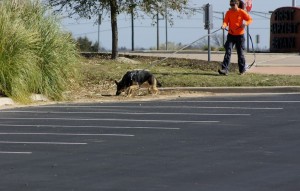
Kiba and Jeannette following a trail